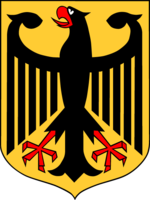Federal Coat of Arms of Germany
|
|
The eagle is the heraldic animal of the coat of arms of the Federal Republic of Germany. Its history as an emblem is far longer, however. To the Germanic tribes the eagle was the bird of the god Odin, and by the Romans, too, it was revered as the symbol of the supreme god, of the emperor and of invincibility. From there and through its religious significance in Christendom it came to be incorporated into mediaeval symbolism.
History
 A double-headed eagle (1433-1867) as shown in the coat of arms of Cologne |
| Missing image Prussiaflag_small.jpg The Prussian eagle with the traditional insignia of the emperor - the imperial orb, the sceptre and the crown (1894-1918) |
 Nazi eagle (1935-1945) |
 The Federal Eagle (since1950) |
The origins of the Reich eagle on German soil probably date back to the time of Charlemagne. Around the year 1200 the black eagle on a gold field was generally recognised as the imperial coat of arms. In 1433 the double-headed eagle was adopted for the first time by the Holy Roman Emperor Sigismund. Since then the double-headed eagle came to be used as the symbol of the Roman-German emperor, and hence as the coat of arms of the Holy Roman Empire of the German Nation. From the middle of the 15th century onwards, the respective emperors put the emblem of their dynasty on the eagle's chest.
After the end of the Holy Roman Empire of the German Nation in 1806, a German state and a unified state emblem ceased to exist. In 1815 a German Confederation (Bund) of 39 loosely united German states was founded on the territory of the former German empire. Until 1848 the confederation did not have a coat of arms of its own. The Federal Diet (Bundestag) meeting at Frankfurt am Main used a seal which carried the emblem of Austria , since Austria had taken over the union's leadership. It showed a black, double-headed eagle, which Austria had adopted just before the dissolution of the Holy Roman Empire of the German Nation.
During the 1848 revolution, a new Reich coat of arms was adopted by the German National Assembly that covened in St.Paul's Church in Frankfurt. The black double-headed eagle was retained, but without the four symbols of the emperor - the sword, the imperial orb, the sceptre and the crown. The eagle rested on a golden shield; above was a five-pointed golden star. On both sides the shield was flanked by two flags with the colours black-red-gold. The emblem, however, never gained general acceptance.
In 1867 the North German Confederation was established without Austria and the southern German states, and under the leadership of Prussia. A new coat of arms was adopted, which consisted of a shield with the colours black-white-red, flanked by two wild men holding cudgels and standing on a pedestal.
The eagle was retained during the German Empire (1871-1918) and the Weimar Republic (1918-1933), albeit with variations in symbolic meaning and design.
When Hitler came to power in 1933, the Weimar eagle was retained at first. It was only until 1935 that it was replaced by the emblem of the National Socialist German Workers Party (NSDAP). It showed a black eagle above a highly stylised oak wreath, with a swastika at its centre.
After the defeat of Germany in World War II, 1945, the German state temporarily didn't exist until 1949. In 1950 the newly founded Federal Republic of Germany incorporated the Weimar eagle (now called the "federal eagle") into its coat of arms. The design by Tobias Schwab dates from the year 1926. Since the accession of the German Democratic Republic in 1990, the Federal Eagle has been the state symbol of reunified Germany.
The Federal Eagle today
Official depictions of the federal eagle can be found not only in the federal coat of arms but also on the federal institutions flag, the standard of the Federal President and official seals. These are designs by various artists of the Weimar period and differ primarily in the shape and position of the wings. In addition to the official depictions, artistic renderings of the federal eagle are permitted and have found their way onto coins, stamps and the letterhead of federal authorities.de:Wappen Deutschlands

